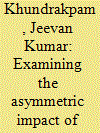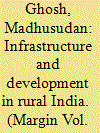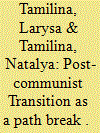|
|
|
Sort Order |
|
|
|
Items / Page
|
|
|
|
|
|
|
| Srl | Item |
| 1 |
ID:
155101


|
|
|
|
|
| Summary/Abstract |
Though an accumulating body of work has analysed monetary policy transmission in India, there are few studies examining the asymmetric aspect of the transmission. Against this backdrop, segregating the interest rate setting process captured by a Taylor rule type into unanticipated and anticipated components, this article analyses the asymmetric effects of monetary policy on aggregate demand and its components, and inflation in India using quarterly data from 1996–97Q1 to 2013–14Q3. It finds that unanticipated hikes and cuts in the policy rate have a symmetric impact on aggregate demand, but differentially impact the components. While the impacts on investment are negative and symmetric, they are asymmetric on private consumption, with only an unanticipated cut in policy rate having a significant negative impact. Government consumption is unaffected by monetary policy shocks. The impact of unanticipated interest rate changes on inflation is negative and symmetric. Anticipated policy rate changes also have a negative impact on aggregate demand and its components, except for government consumption, but between certain levels, such changes are ineffective, indicating a neutral impact. Anticipated policy rate changes have a negative impact on inflation at all levels.
|
|
|
|
|
|
|
|
|
|
|
|
|
|
|
|
| 2 |
ID:
155103


|
|
|
|
|
| Summary/Abstract |
Estimating the factors affecting participation decisions of physical activity has continuously received significant research attention. However, the effects of income and demographic factors on physical activity intensity have seldom been studied thoroughly, especially in developing countries. To fill this research gap, the income and demographic determinants of the time spent on both vigorous- and moderate-intense physical activities among Malaysian adults are estimated using a censored regression model. The results are comparable to those in developed countries, such as the USA and Australia, which show that income, age, education level and being unemployed are negatively associated with the time spent on both vigorous- and moderate-intense physical activities. Compared to females, males spend more time on vigorous-intense physical activity but less time on moderate-intense physical activity. The present study suggests that acquiring a better understanding of the factors that can affect physical activity intensity is important for policy development
|
|
|
|
|
|
|
|
|
|
|
|
|
|
|
|
| 3 |
ID:
155100


|
|
|
|
|
| Summary/Abstract |
This article evaluates rural infrastructure facilities in 16 major states of India, and examines their impacts on some income and non-income dimensions of rural development. Despite several public initiatives for infrastructure development in rural India, facilities continue to be poor and progress has been mostly unsatisfactory with differential performance across states. Estimates of regression coefficients of the composite indices and individual indicators of rural infrastructure reveal that improved physical and social infrastructure and livelihood opportunities enhance agricultural productivity and output, improve literacy and life expectancy, and reduce poverty and infant mortality. The results, showing the relative importance of various infrastructures, suggest that the government should prioritise additional investments in electricity, roads, irrigation, housing and telecommunications to enhance overall well-being.
|
|
|
|
|
|
|
|
|
|
|
|
|
|
|
|
| 4 |
ID:
155102


|
|
|
|
|
| Summary/Abstract |
This article explains the peculiarities of institutional effects on growth rates in postcommunist countries. By proposing a certain dependence of the institution–growth nexus on the mode of institutional grafting, the distinction between drift-phase and path-breaking institutional change is introduced. Theoretical juxtapositions show that transition countries’ institutions built through path-breaking institutional reforms differ from those that emerge evolutionarily in the drift phase in a twofold manner in their relationship to growth. Growth rates of their economies are less likely to depend on the quality of legal institutions and are more likely to be a function of the maturity of political institutions. In addition, legal institutional change in the post-communist world is a product of the quality of the political environment to a greater extent than their drift-phase alternatives. These propositions are tested empirically based on a sample of 87 countries derived from the POLITY IV Project’s website.
|
|
|
|
|
|
|
|
|
|
|
|
|
|
|
|
| 5 |
ID:
155099


|
|
|
|
|
| Summary/Abstract |
The aim of this article is to investigate the relationship between urbanisation and economic growth, while controlling for the agricultural sector, industrial development and government expenditure in Nigeria. The autoregressive distributed lag (ARDL) approach to cointegration is applied to examine the long-run relationship between the variables over the period 1961–2012. In the process of estimating the long-run coefficients, the ARDL method is augmented with a fully modified ordinary least squares (FMOLS) estimator and a dynamic ordinary least squares (DOLS) estimator. The direction of causality between the variables is examined through the vector error correction method (VECM) Granger causality test. The results establish the existence of a long-run relationship in the variables. The results of the long-run regressions indicate the presence of long-run causality from urbanisation, agriculture and industrialisation to economic growth. Due to the deficiencies associated with the single-equation methods (including the ARDL model), we also use the structural vector error correction model (SVECM) to analyse the relationship between the variables. The impulse response and variance decomposition analyses derived from the SVECM method suggest that urbanisation, agriculture and industrialisation are important determinants of economic growth. The implications of the results are discussed.
|
|
|
|
|
|
|
|
|
|
|
|
|
|
|
|
|
|
|
|
|